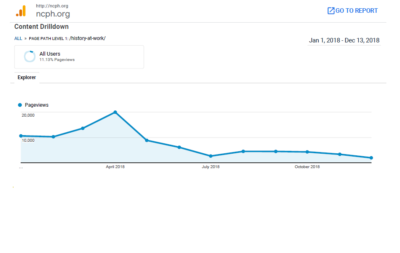Highlights of History@Work in 2018
04 January 2019 – editors
public history, digital media, methods, digital history, scholarship, trends, profession, race, conference, gender/sexuality, review

NCPH Google Analytics snapshot for History@Work, 2018.
2018 has drawn to a close, and the History@Work editors would be remiss if we deprived our readers of that beloved tradition: the year-end redux. We want to give you a sense of the most widely read, discussed, shared, and impactful posts of the year, but we find ourselves faced with the perennial problem of digital analysis: how do we assess impact? We can look at comments and tags on WordPress, the platform we use for the blog; yearlong pageview Google analytics; retweets, likes, and “engagement” scores on Twitter; and Facebook shares, likes and comments. Any method alone would miss important ripples in the pond, but using all of these tools still deprive us of the invisible impressions that may lead to future conversation and reflective scholarship. Nevertheless, in the spirit of the season, we offer you, dear reader, this view from our editorial cluster.
Our most widely shared and liked blog post on Facebook was historian Mimi Eisen’s project showcase about her work of digital public history, Hidden In Plain Sight: Cemeteries and Civil Rights. The piece offers a thoughtful contextualization of the project as both a revelation of a hidden landscape and a re-peopling of an empowered African American past that had been whitewashed in public memory. This piece is reflective of a recent swell in African American public history, coinciding with the opening of the new National Museum of African American History and Culture, to which The Public Historian dedicated a special issue in August looking at four decades of Black Museum history.
Twitter engagement scores, an amalgamation of clicks, favorites, retweets, and comments, reveal an orientation toward news related to NCPH endeavors, including the recommendations of our Diversity and Inclusion Committee (NCPH Inclusion) and Mary Rizzo’s report on sexual harassment and gender discrimination in public history; the hiring of our new Digital Media editor, Nicole Belolan; and our first Twitter Mini-Con, (Re)Active Public History. Twitter users were also, understandably, interested in Twitterstorian Kristen Baldwin Deathridge’s thoughtful personal digital history and advice for “Teaching the Digital Self.” Digital public history remains a topic of importance to History@Work and NCPH’s Digital Media group. You can follow the arc of the blog’s consideration of this topic by clicking here.
Comment threads on History@Work show engagement with posts that unite personal reflection with public history work, such as Rebecca Bush’s February 2018 exploration of Carson McCullers’ sexuality through material culture, and Gregory Rosenthal’s poignant post about the evolution of their article “Make Roanoke Queer Again.” Our editors’ conversation on interpreting immigration generated some helpful suggestions for additional examples, and the project showcase featuring Historians for a Better Future received support for their novel, yet historically-grounded technique for protest through education. This post was also one of our most popular on social media, demonstrating that public interest in addressing controversial memorials remains high. 2018 also featured an engaging series of posts related to the February issue of The Public Historian which highlighted examples of public historians rapidly responding to tragedies in their communities. Notable as well are they ways in which NCPH members make use of the Public History Commons for developing working group proposals which subsequently generate thoughtful content for History@Work, including posts on agriculture, capitalism, campus history, and digital access to primary sources. Finally, Annette Gordon-Reed’s 2016 post about the Hamilton musical continues to generate buzz.
As usual, Google Analytics showed a peak of readership corresponding with the NCPH annual meeting in Las Vegas last April. Visitors enjoyed the many posts relevant to the local area and conference goings-on, and the editorial team will strive to publish timely conference-related material sooner this year.
We ask now for a drumroll for the most visited post of 2018: Pamela Curtin and David Trowbridge’s project showcase for Marshall University’s Clio app. Public history at the intersection of digital and geographical space remains ripe for exploration.
We would like to thank everyone who contributed a post, commented on a post, assigned posts to your students, or told a friend about History@Work this year. We are indebted to you for your critical engagement and for keeping the conversation lively! As always, if you have any questions about or suggestions for History@Work posts in 2019 (as well as any insights into novel ways to analyze impact), we invite you to comment here or email us at: [email protected].
~History@Work Editorial Team



